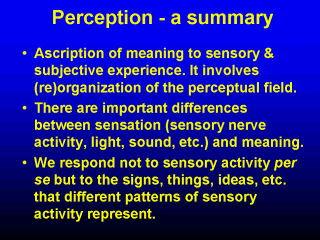| front |1 |2 |3 |4 |5 |6 |7 |8 |9 |10 |11 |12 |13 |14 |15 |16 |17 |18 |19 |20 |21 |22 |23 |24 |review |
 |
This slide summarizes
perception: Perception is about meaning. What we perceive in the world is not meaninglessness but the opposite. As adults, our world is a symbolic world. It is what these symbols mean to us that drives how we think, feel and act. Sensation is the name given to the experience of activity in different sensory pathways - a sensation of light, sound, touch, taste, or smell may be experienced as pleasant, neutral or noxious. Noxious sensations provide some evolutionary advantage in that they help us avoid potentially harmful aspects of the environment thus providing a survival advantage. A nematode worm will avoid high localized concentrations of hydrogen ions in a solution, and even bacteria show tropism along chemical concentration gradients. But, most would agree, to claim these creatures feel pain or pleasure is not defensible. Humans are a bit more sophisticated than worms in the structure of their nervous systems. They are also one of the few species on the planet that actively make use of signs or symbols to represent things and manipulate abstractions called ideas to model different realities. The human nervous system is a set of pattern generation and recognition devices which attempt to derive regularities from sensory information. It uses the experience of known regularities to generate new matches against current sensory activation. “Things” don’t come in through the senses to be passively registered; the brain creates possibilities and matches them against what is receives. In other words, the brain creates the reality you experience from sensory activity and adds significant amounts of “value” to provide what it thinks is the most accurate representation of what is happening and models what possible developments would provide optimal outcome referenced against current needs or preferences. |